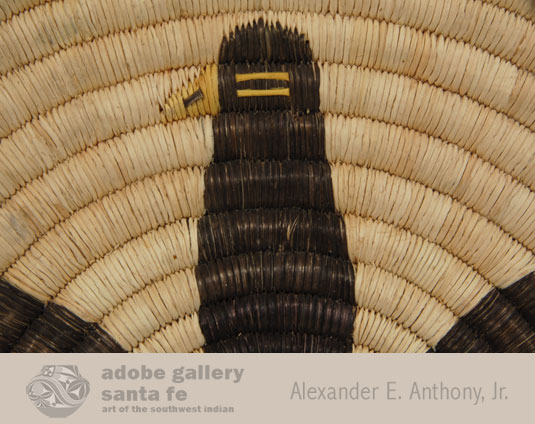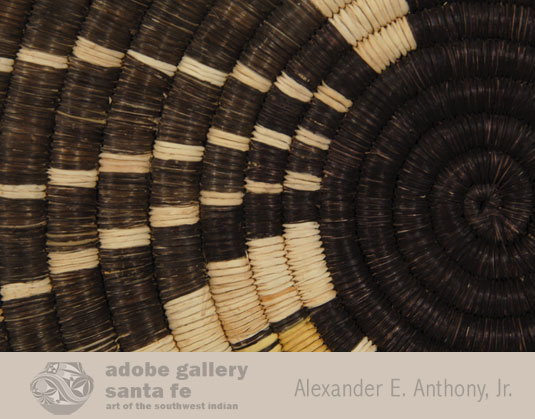Hopi Second Mesa Plaque with Eagle Design [SOLD]
+ Add to my watchlist Forward to Friend
- Category: Trays and Plaques
- Origin: Hopi Pueblo, Hopituh Shi-nu-mu
- Medium: galleta grass, yucca leaves
- Size: 12” diameter
- Item # C3900B SOLD

The Hopi Indians have a long tradition of existing in the harsh, dry climate of Arizona where they rely on nature to provide for their livelihood. They have a strong religious belief demonstrated with their annual Katsina dances and in less visual means. They have preserved their traditional ways for a thousand years when one would expect that today’s modern culture would have supplanted tradition.
One of the ways the Hopi have preserved traditions is through making baskets. Outsiders may view the baskets as curio items or decorative items, but to the Hopi women who make them, they have a very important function in their lives.
The plaque is an especially important item in preserving the women’s role in Hopi society. Plaques are presented to newborn babies, young mothers, men as a wedding gift, as paybacks for gifts or favors, and in kiva ceremonies. Those are their main purposes and making them to sell to tourists is a secondary purpose. Plaques may be hung from the sash of a Katsina or from the hair of a Long Hair Katsina. They are used in initiation ceremonies and as rewards in young men’s footraces. Most importantly, they are used in the women’s basket dance.
Second Mesa basketry is made in the same manner as of a thousand years ago. All materials are derived from nature and, in most instances, from the general area of the villages. Dyes used are from plant materials and not commercial sources.
This plaque is completely devoted to displaying the image of an eagle. The foundation is made from grasses and the weft from yucca leaves that have been split into narrow strips and sun dried or dyed. A loop was included during the weaving to provide for hanging the plaque. A note attached to the back states that the weaver was Mollie Talas and the plaque was purchased on April 23, 1965 from the weaver. Molly Talas was from the Hopi Pueblo village of Shungopavi, on Second Mesa.
A 1992 photograph of Mollie Talas weaving a basket is published in the Helga Teiwes book referenced below. There is also a finished plaque with an eagle design similar to this one shown in the photograph.
Condition: original condition
Provenance: the Hopi Second Mesa Plaque with Eagle Design is from the owner who purchased it directly from the weaver in 1965.
Recommended Reading: Hopi Basket Weaving – Artistry in Natural Fibers by Helga Teiwes.

- Category: Trays and Plaques
- Origin: Hopi Pueblo, Hopituh Shi-nu-mu
- Medium: galleta grass, yucca leaves
- Size: 12” diameter
- Item # C3900B SOLD



